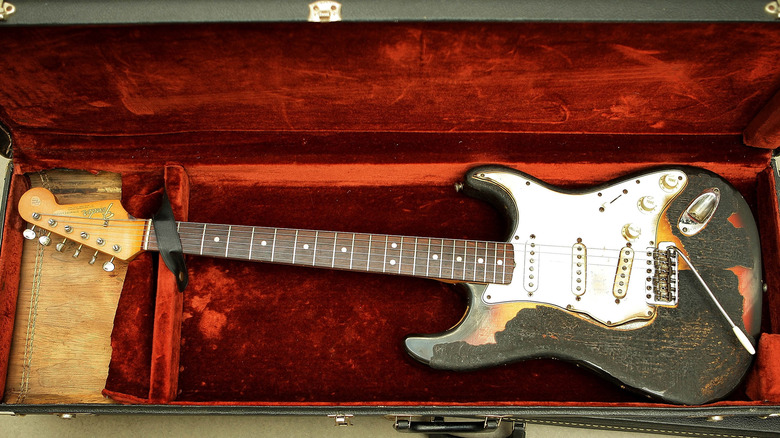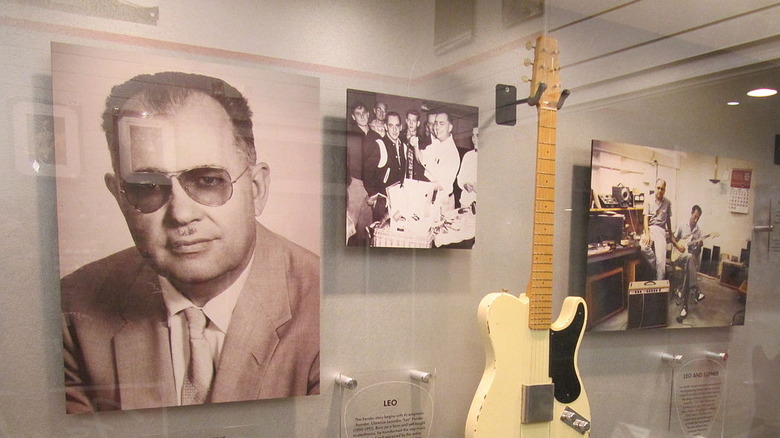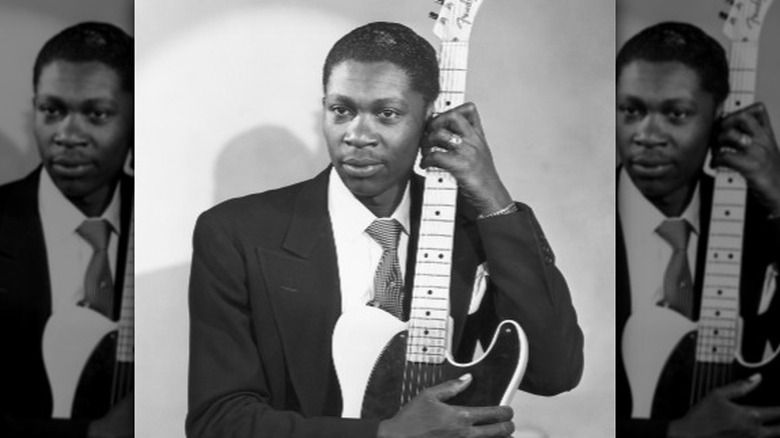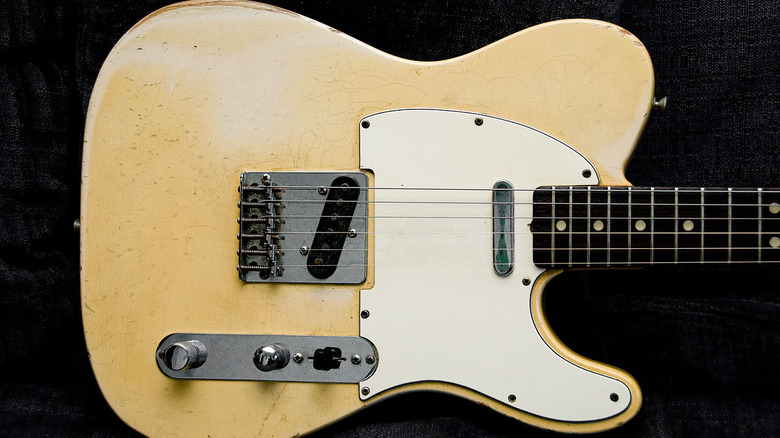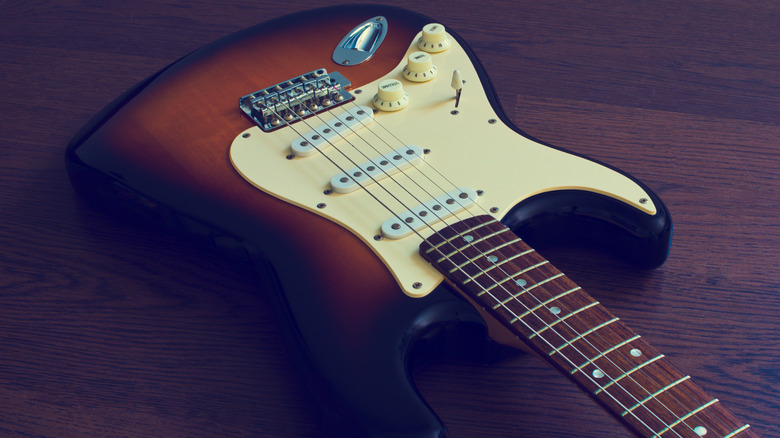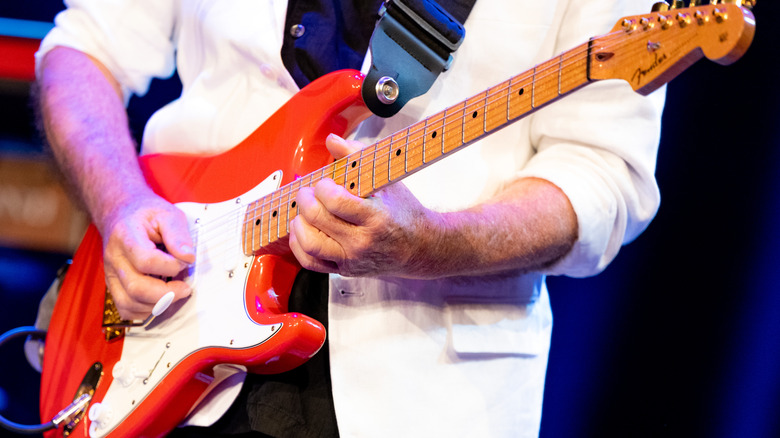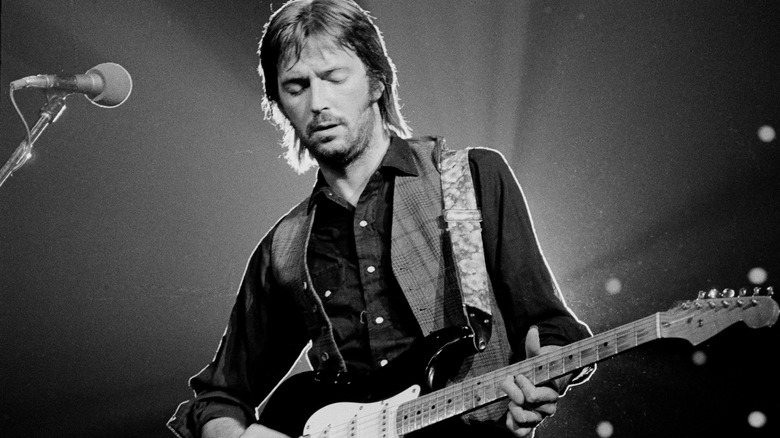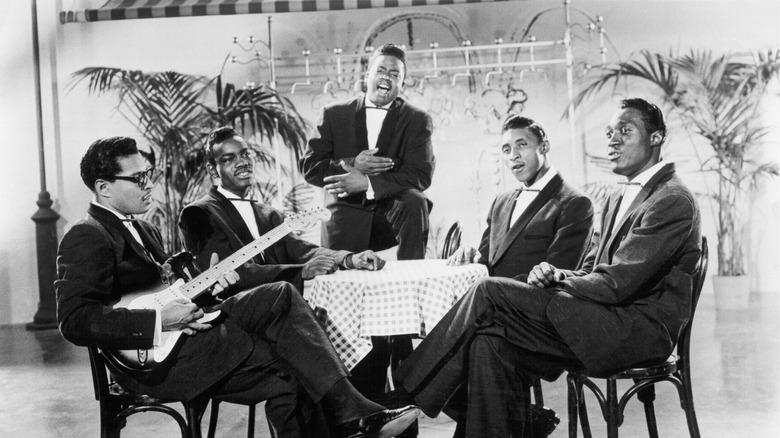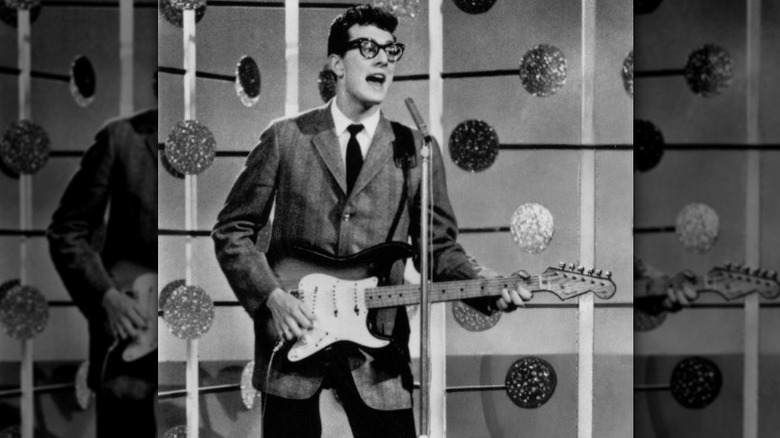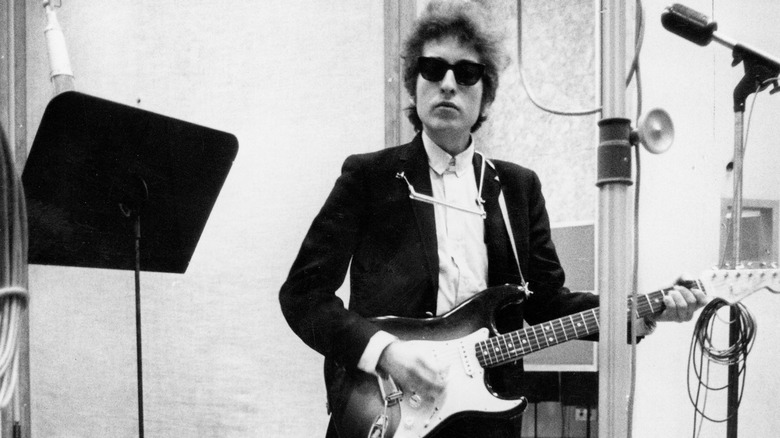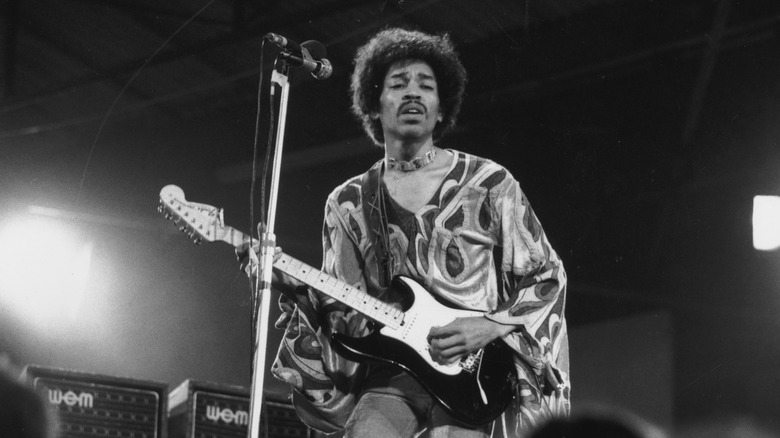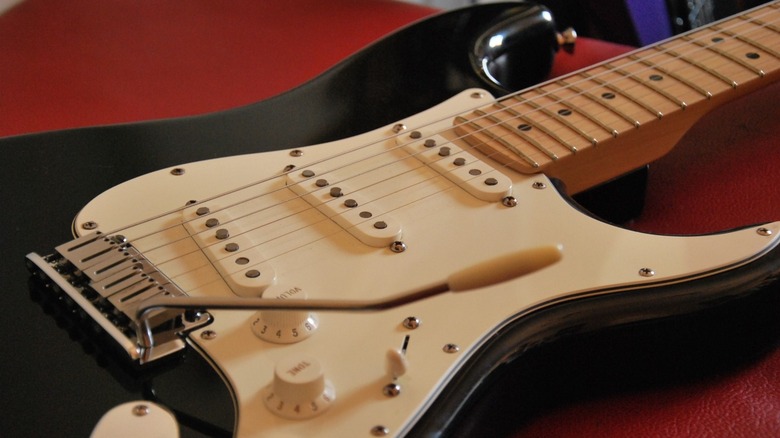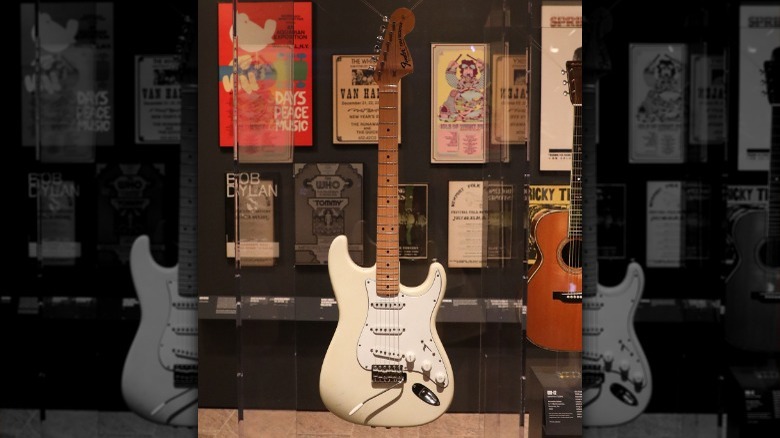The Story Behind The Fender Stratocaster Guitar
If you were to ask any random sampling of people to draw a guitar, it's quite possible that many of them would draw something resembling a Fender Stratocaster, even if they weren't musicians and didn't know anything about guitars. That's because the "Strat" is one of the most iconic and influential musical instruments ever designed, a guitar that introduced a host of features that have become standard, and a visual look that has been copied and emulated endlessly.
The impact of the Fender Stratocaster goes far beyond its look and style, however. As noted by BBC Culture, the guitar design combined that style with versatility, and has become indelibly associated with rock music of all kinds. It continues to be popular with professional musicians around the world, many of whom are passionately dedicated to their "Strats."
But the Stratocaster was not an overnight success or an accident of inspiration. Its history is one of thoughtful design, problem-solving, and slow success. It's also a story of corporate fumbling that came close to destroying an iconic brand just as it was attaining legendary stature, and a brand recovery for the ages that allowed this distinctive instrument to become a generic image for "cool guitar." Here's the story behind the Fender Stratocaster guitar.
It's inventor did not play guitar
As noted by BBC Culture, there is a surprising fact about Leo Fender, the man who developed the Stratocaster (and the almost-as-iconic Telecaster): Fender, who transformed the electric guitar — and had an immense impact on popular music — couldn't play a lick on his own instrument. In fact, according to the Los Angeles Times, he couldn't even tune a guitar.
It wasn't that Fender hated music — he played the piano and saxophone a little. But music wasn't Fender's passion: His true love was engineering and electronics. As noted by Guitar.com, when the Great Depression hit, Fender lost his job, opened a radio repair shop to pay the bills, and began designing sound systems. This brought him into contact with local musicians, and he began making guitar amplifiers and other music-related devices to supplement the business. By 1947, Fender had renamed his business the Fender Electric Instrument Company.
Fender eventually brought in guitarists to work with him at the company, and while he wasn't very musical, he understood the practical needs of the musicians in the area, and put his inventive mind to designing products and instruments that would solve their problems.
Fender pioneered solid-body guitars
As noted by the National Inventors Hall of Fame, Leo Fender didn't invent the solid-body electric guitar — Les Paul did. But according to Britannica. Fender was the first to design one that could be mass-produced.
BBC Future reports that the inspiration for the solid-body guitar came from jazz and big-band musicians. Plenty of these bands included Spanish-style guitars in their mix, but the guitarists found their instruments were drowned out by the roar of the other instruments. The answer to the problem was to electrify the instruments and pump the sound through an amplifier, allowing the guitar sound to be as loud as the other instruments.
Early electric guitars were fairly primitive, however — while they definitely amplified the volume, the tone and sound of the notes weren't exactly great. As noted by Guitar.com, for many years, solid-body electric guitars weren't taken seriously as professional instruments. When Leo Fender designed the Esquire (released in 1950), he'd finally delivered a solid-body guitar that had a good tone, could be played in a variety of ways, and could be amplified sufficiently for a live performance. The Fender Esquire was a leap forward, but it was still pretty rudimentary. It only had one pickup — the magnetic device that translated sound vibrations into electrical signals — and only one cutout, the curve carved into the body to allow a guitarist to reach the upper strings. Luckily, Fender wasn't done innovating.
The Telecaster foretold the Strat
As iconic as the Fender Stratocaster is, it wouldn't exist if not for the success of the Fender Telecaster. As noted by GuitarPlayer, after World War II, live music began to increasingly feature fast, loud styles like rhythm and blues and honky tonk. These musical styles required more volume from their guitars and a "faster" neck that would allow playing lead guitar parts.
According to Guitar.com, Leo Fender had already introduced the Esquire in 1950. But the Esquire had room for improvement — it only had one pickup translating sound waves into electric signals, for example. As noted by Guitar World, Fender almost immediately began improving the Esquire, adding a second pickup — which allowed guitarists to switch between different tones — and a bolted-in neck that could be replaced if it warped or was otherwise damaged. Prior to the Telecaster, most guitar necks were glued in, which meant replacing them was much more difficult.
Reverb News reports that Fender released the follow-up to the Esquire, called the Broadcaster, in 1950. It was tweaked and re-released as the Telecaster in 1951, establishing Fender as a leading force in the guitar world — and laying the groundwork for one final revision to the design that would become the Stratocaster.
A last-minute redesign led to glory
When it came to guitars, Leo Fender's genius lay in his ability to refine and improve existing technologies. The Telecaster guitar was introduced in 1950, but Fender immediately began working on making it better. As noted by Guitar.com, he invested six months and thousands of dollars on improving the vibrato system for the guitar. As explained by Artist Guitars US, a vibrato bridge allows the guitarist to temporarily adjust the pitch of the strings via a bar. This feature gives the player a much broader range of notes they can hit while playing without having to re-tune the guitar.
But Fender's vibrato system was a bust. It worked, but it lowered the sustain, so the notes didn't last as long as desired, and it altered the tone of the strings negatively. Enter Freddie Tavares. Tavares had been a professional guitarist for years — he played on the "Looney Tunes" theme song and later played the ukulele on Elvis Presley's "Blue Hawaii." Tavares redesigned the bridge and solved the problem.
According to Fender, Tavares is also responsible for a last-minute redesign of the Stratocaster's iconic body, based on a bass guitar Fender had produced called the Precision Bass, and giving it its dual "horn" shape. Finally, they needed a name for the new guitar — and Leo Fender didn't come up with that, either. His chief of sales, Don Randall, named it.
The Stratocaster made playing guitar more comfortable
As noted by Happy Magazine, prior to the Stratocaster, most electric guitars still resembled acoustic guitars in terms of shape and size. But the way guitarists were playing these modern, electrified instruments was changing, and solid-body guitars didn't have the same constraints because they didn't need an acoustic chamber to generate sound.
That meant that the guitar body could be shaped and sized very differently. Guitar World reports that country musician Rex Gallion told Leo Fender that one big problem with the company's prior model, the Telecaster, was the fact that it was very uncomfortable to hold for long periods of time. Freddie Tavares, himself a professional musician, sketched out a body design that was the first guitar body to take ergonomics into account. As noted by the Museum of Modern Art, the Stratocaster design consciously left traditional guitars behind in pursuit of comfort, with double cutaways allowing easier access to the strings, a neck with the tuning bolts all on one side for easier access, and many other performance-focused design tweaks.
The design that Fender released was also avant-garde and simply cool when released in 1954. The Strat might look normal to us today because we're used to it, but back then it looked like a guitar from the future.
The design has barely changed over the years
The first Fender Stratocaster was released in 1954. As noted by Gearnews, nearly 70 years later, the Strats you can buy new are almost identical in terms of their fundamental design.
There are two basic reasons the Stratocaster hasn't been refined much over the years. According to the Museum of Modern Art, the Strat was built in a modular way that encouraged customization. That meant that a guitarist could buy a stock Strat and then make whatever changes they wished in order to get the perfect tone, mechanical action, or other aspects that they desired. In fact, according to Guitar.com, many of the most famous Strats in music history are heavily customized — Stevie Ray Vaughan's legendary Number One Strat, for example, had a 1962 body combined with a 1963 neck and pickups that dated to 1959. And Eric Clapton's Blackie Strat was a combination of three different Stratocaster guitars.
The other reason? As Fender itself suggests, the guitar was simply designed extremely well to begin with. The Stratocaster was designed around comfort and playability, and they got it right on the first try, resulting in a design so nearly perfect there was little reason to make any changes over the years.
It took a while to catch on
When the Fender Stratocaster hit the market in 1954, it didn't look like any guitar that had come before — as noted by "The Stratocaster Chronicles": the new guitar was "as far removed from conventional guitars as, say, a baritone ukulele or even a banjo." As a result, many musicians viewed the Strat as something no professional would ever play. For several years after its introduction, sales were pretty bad.
How bad? According to "The Stratocaster Guitar Book," the Strat initially sold for $249.50 (about $2,700 in 2022, per the U.S. Inflation Calculator), which was comparable to Gibson and Gretsch models. Yet the Strat sold just 720 units by 1955.
One reason for the slow sales was the unusual look of the guitar. Another was the fact that the Strat's innovative vibrato system — which allowed guitarists to "bend" notes to different pitches by manipulating a bar — was so new dealers didn't know how to explain it to their customers. Fender had trouble getting music stores to even stock the Strat because there was no demand for it, and their salespeople didn't understand why any musician would want or need it. And as noted by Fender, although rock 'n' roll burst onto the scene in 1950, contrary to popular belief, the main instruments of early rock were the piano and the saxophone — not the guitar.
Buddy Holly made made the Strat cool
The Fender Strat didn't become an immediate success. By 1957, three years after its release, it still wasn't exactly a well-known or even popular instrument — Fender itself noting: "... many still hadn't seen one ...." For a moment, it looked like the guitar was destined to be a footnote, but then everything changed on December 1, 1957.
As reported by "The Stratocaster Guitar Book," that was the day that Buddy Holly performed on "The Ed Sullivan Show." Holly was already a huge name in rock 'n' roll (AllMusic notes that his song "That'll Be the Day" was re-released in May 1957 and hit #1.), so his appearance was a big deal. And when he stepped out onto people's television screens that evening, everything about his band was pretty conventional for a rock 'n' roll artist of the time — except his unusual guitar. Holly also posed with a Strat on the cover of his 1957 album "The Chirping Crickets."
By the end of the 1950s, the Strat was no longer a curiosity, and several future superstars — including Buddy Guy, Jimi Hendrix, and Dick Dale — would soon purchase Stratocasters that would become part of their own legend, and a symbol of rock music itself. It's no surprise that when Bob Dylan shocked his fans by "going electric" in 1965, he chose to do so using a Fender Stratocaster, according to The Guardian.
Everything changed in 1965
As noted by Guitar World, by 1965 the Fender Stratocaster had become so well-associated with rock music that it was the guitar of choice when Bob Dylan shocked his folk fanbase by "going electric." In fact, the Strat was the guitar of choice for a host of rock legends, from Eric Clapton to Jimi Hendrix. But everything was about to change.
As described in "Fender Telecaster and Stratocaster: The Story of the World's Most Iconic Guitars," Leo Fender had been suffering from a persistent strep infection since the mid-1950s. Worried about his health, the Los Angeles Times reports that Fender sold his company to CBS for $13 million. According to Reverb, this had a slow but steady negative impact on the quality of the guitars the company produced. Eventually this decline became so dramatic that musicians and collectors began dividing Fender guitars into "Pre-CBS" Fenders and everything else. Although Leo Fender was technically employed as a consultant for the new company, he apparently wasn't really consulted, and according to "The Stratocaster Chronicles," by 1966, the company began to lose key executives who refused to sign off on low-quality components.
Eventually, Fender's prior reputation for great sound quality and innovative design was replaced by a reputation for the exact opposite. Meanwhile, as related by "The Birth of Loud," Leo Fender went to a new doctor in 1967 and was cured of his infection.
Jimi Hendrix saved the Strat's reputation
As described in "The Stratocaster Chronicles," after Leo Fender sold his company to CBS, the quality — and reputation — of the Stratocaster (and the rest of Fender's lineup) had sunk considerably. Once the coolest guitar in the world, it was slowly becoming known for being a cheap, mass-produced instrument.
That might have been the end of the Strat's legend, but it had one card left to play — the affection that bonafide rock stars had for it. And as noted by Fender, there was no bigger "Stratocaster fanatic" than the legendary Jimi Hendrix. Per MusicRadar, other superstar guitarists like Jimi Page tended to favor Les Paul models, but Hendrix almost exclusively played Strats. When Hendrix played "The Star Spangled Banner" at his iconic Woodstock performance, it was a Strat that got the flame treatment, and according to Rolling Stone, when Hendrix famously burned his guitar at the Monterey Pop Festival, it was a Strat that got the flames.
As the Metropolitan Museum of Art makes clear, Hendrix was instrumental in making the Fender Stratocaster "cool" again in the wake of its disastrous sale to CBS. While musicians still preferred the pre-CBS models of the guitar, it was forever associated with one of the best and most creative guitarists of all time.
In 1985 Bill Schultz began rebuilding
As noted in "Fender Telecaster and Stratocaster," by the early 1980s, CBS was well aware of how far Fender's reputation had slipped. After more than a decade of producing poor-quality instruments, it brought in a new executive team in 1981 to revive the company's fortunes. Included among the new leadership was a man named Bill Schulz.
Guitar.com reports that when CBS decided to sell Fender in 1985, Schulz pulled together investors and bought the company for $12.5 million. They didn't purchase Fender's factories and all of the patents, however, so the company shut down its U.S. operations and moved everything to Japan — a situation that changed quickly when Japan's economy began to boom, making it more appealing to get back to domestic production in the U.S.
Most importantly, per "The Stratocaster Chronicles," Schulz and his new team designed a new, updated Strat called the American Standard in 1986 that debuted to rave reviews. After years of creative stagnation, quality issues, and mismanagement, Fender was back on track — as noted by Music Inc., when Bill Schulz passed away in 2006, he had re-established Fender as a major force in the world of guitars.
Strats can be worth a *lot* of money
Today, the Fender Stratocaster retains its iconic status as an all-time classic instrument — and they're not cheap. As of 2023, new Strats start at around $850 (via Fender), and if you drift into the "Signature" Strats associated with famous guitarists, the price can soar close to $3,000.
But that's nothing compared to vintage Strats — especially the so-called "pre-CBS" Strats, manufactured before CBS purchased the company and kicked off a long period of decline, per Reverb. If you happened to find a 1950s-era Strat at a garage sale, for example, you would be in for a decent payday — according to vintage guitar dealer Garrett Park Guitars, the price for 1950s-era Strats can range from an eye-popping $6,500 to an even more eye-popping $150,000.
And according to Stringjoy, four of the ten most expensive guitars ever sold at auction have been Fender Strats — owned by the likes of David Gilmour and Jimi Hendrix. The bottom line? The Fender Strat is a legendary instrument that has regained much of its former reputation — although true Strat fanatics will splash out for the pre-CBS models made under the watchful eye of Leo Fender himself.
